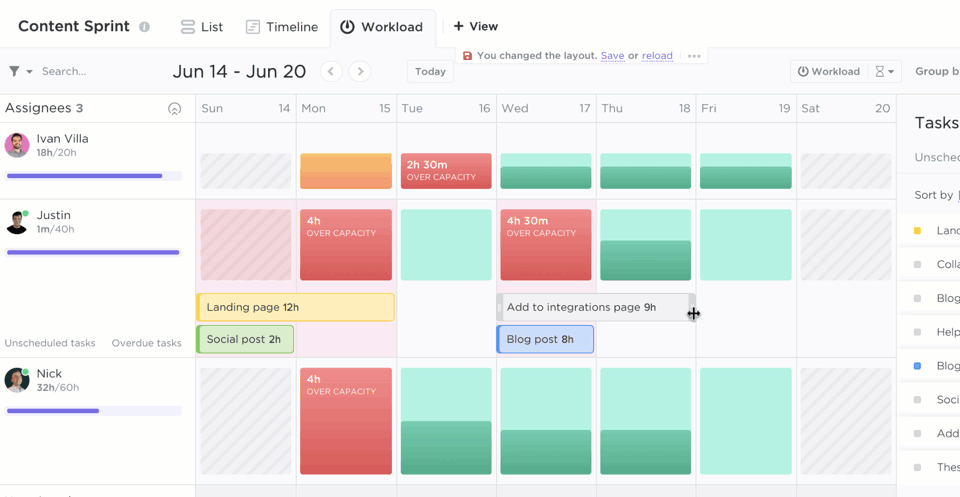تخيل هذا: أنت تقيم حفلة. منزلك مليء بالضيوف المحتفلين. يقول أحدهم: "لقد بدأت أشعر بالجوع... لنطلب بعض البيتزا!"
أنت تحاول معرفة عدد البيتزا التي ستطلبها. الكثير من البيتزا، وستعلقون في تناول بقايا البيتزا لأيام. عدد قليل جداً ولن يحصل بعض ضيوفك على شريحة.
ولكنك مقيد أيضاً بمساحة المنضدة والمال الموجود في محفظتك.
كيف يمكنك إطعام الجميع مع الحصول على أكبر قدر من القيمة من أموالك؟
مثل منظمي الحفلات، يجب أن يعرف كل مدير مشروع كيفية تخصيص الموارد بحكمة. لا يوجد مشروع لديه ميزانية غير محدودة أو عدد غير محدود من أعضاء الفريق، ولكن يمكنك استخدام تخصيص الموارد لزيادة الإنتاجية ونجاح المشروع.
الأمر كله يتعلق بالإعداد الشامل و التخطيط الاستراتيجي حول تحقيق الاستفادة القصوى مما لديك.
تعلم كيفية تخصيص موارد كافية لجميع مشاريعك بحيث تنجز المهمة - ويحصل الجميع على شريحة من البيتزا. لنحتفل!
![]()
ما هو تخصيص الموارد؟
تخصيص الموارد هو عملية تحديد جميع الموارد المتاحة لديك - سواء كانت عمالة أو أموالاً - لمشروع ما ثم تخصيصها بشكل استراتيجي للمهام التي تمكنها من القيام بأفضل ما لديها من عمل.
بالنسبة للوكالات التي تعمل على مشاريع متعددة لعملاء مختلفين، فإن تخصيص الموارد هو المفتاح لفهم الفوضى الإبداعية. إن مطابقة الشخص المناسب، أو المورد المناسب، مع المشروع المناسب يجعل الجميع أكثر سعادة في النهاية. يتسنى لموظفيك العمل على المشاريع التي تناسبهم بشكل أفضل، لذلك من المرجح أن يحصل العملاء على جودة عالية مخرجات المشروع والنتائج
مع تطور المشاريع وتغير توقعات العملاء، يتم إعادة تخصيص الموارد للحفاظ على التقدم في المسار الصحيح مع الجدول الزمني للمشروع s.
ما الذي يعتبر موارد؟
مواردك هي جميع أصول الشركة اللازمة لإكمال المهام أو المشاريع. قد تشمل هذه الموارد
- الأفراد
- الفرق أو الأقسام
- الميزانية
- الوقت
- الأجهزة والبرمجيات
- العقارات
- العمليات
- الملكية الفكرية
- التقنيات ومجموعات المهارات
من المسؤول عن تخصيص الموارد؟
عادةً ما يكون مدراء المشاريع هم المسؤولون عن تخصيص الموارد لأنهم الأكثر وضوحًا وتحكمًا في ميزانيات المشاريع, نطاق العمل وإدارة المهام. ومع ذلك، قد تفصل المؤسسات الكبيرة بين هذه المسؤوليات عبر عدة أدوار أو قد تخصص إدارة الموارد الأقسام
ذات الصلة:_
_/مرجع/ مدونة؟ p=9560* تسويةالموارد_ */%/href/_
فوائد التخصيص الفعال للموارد
إن عدم تخصيص مواردك بشكل جيد يشبه إرسال شخص واحد فقط لإحضار عشر فطائر بيتزا بمفرده بينما يتحدث الـ 15 شخصًا الآخرين في المنزل. سيستغرق الأمر جهدًا ووقتًا أكبر بكثير من شخص واحد لإحضار تلك البيتزا، مما يعرض الجميع لخطر أن يعلقوا في تناول البيبروني البارد.
مشكلة!
لماذا لا ترسل ثلاثة أشخاص للمساعدة، حتى يتمكن الجميع من الاستمتاع بقطعة دافئة في أسرع وقت ممكن؟

استخدم طريقة عرض عبء العمل في ClickUp لمعرفة من هو متقدم أو متأخر وسحب المهام وإفلاتها بسهولة لإعادة تخصيص الموارد
يمكّنك تخصيص الموارد من استخدام عمالتك وأموالك وأصولك إلى أقصى إمكاناتها، بحيث يتلقى العملاء على الأرجح عملاً عالي الجودة. وفي الوقت نفسه، تقلل وكالتك من إرهاق الفريق من خلال توزيع العمل بالتساوي.
تشمل الفوائد الأخرى لتخصيص الموارد ما يلي:
- يزيد من الكفاءة. يساعد تخصيص الموارد الوكالة على تولي أكبر عدد ممكن من المشاريع التي يمكن لفرقك التعامل معها - لا مزيد من الفرص الضائعة بسبب زيادة عدد الموظفين أو فشل المشروع بسبب نقص الموظفين
- يعززالتعاون*يعرف العميل وفريقك من يعمل على ماذا لأنك قمت بتقسيم المهام والمسؤوليات بشكل واضح بين أعضاء الفريق
- يزيد من هوامش ربح وكالتك. احصل على أقصى استفادة من ميزانية كل مشروع وتحكم في تكاليف الموظفين
- تعزز رضا العميل. تقدم نتائج أفضل للمشروع من خلال إبقاء المشاريع على المسار الصحيح وتعيين الأشخاص المناسبين لكل مهمة
## كيفية إدارة الموارد وتحديد توقعات العميل
نظرًا لأن تخصيص الموارد يأخذ في الاعتبار الموارد المتاحة لمشروع ما في وقت معين، فهي خطة قصيرة الأجل - ولكن لها تأثيرات بعيدة المدى. إنها أداة حاسمة لـ تخطيط القدرات وإدارة توقعات العميل. من خلال التخصيص الفعال للموارد، سيحصل مشروعك على كل شيء وكل شخص يحتاجه ليكون ناجحًا، بما في ذلك الموارد المناسبة والإطار الزمني الواقعي.
المكافأة:% أدوات تخطيط القدرات تنزيل هذا النموذج
تخصيص الموارد هو عمل مستمر قيد التقدم
أنت لا تقوم بتخصيص الموارد قبل بدء مشروعك وتنتهي منه. عليك أن تراقب مشاريعك عن كثب، وتوازن بين قدرات فريقك بعناية وبين متطلبات مشروعك. ونظرًا لأن العوامل التي يمكن أن تؤثر على نجاح مشروعك تتغير باستمرار، عليك أيضًا أن تكون مرنًا بما يكفي لتعديل استراتيجية تخصيص الموارد حسب الحاجة.
ClickUp هو الأفضل برنامج إدارة المشاريع للفرق، مع مجموعة قوية من الميزات لمساعدتك في إدارة مواردك، وإبقاء مشاريعك على المسار الصحيح، وإنجاز الأمور بسرعة نحن نساعد مديري المشاريع وصناع القرار الرئيسيين على تخصيص الموارد والإشراف على دورة حياة المشروع الكاملة مثل المحترفين.
تعرف كيف يمكن أن يساعدك ClickUp أنت وفريقك من خلال اشترك مجانًا اليوم!
وأبقِ مطعم البيتزا المفضل لديك على قائمة الاتصال الهاتفي السريع - لأنك لن تنفد منك أبداً من الجبن اللذيذ بمساعدتنا!

